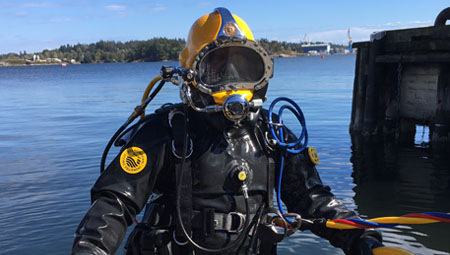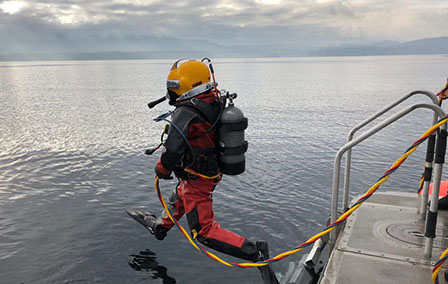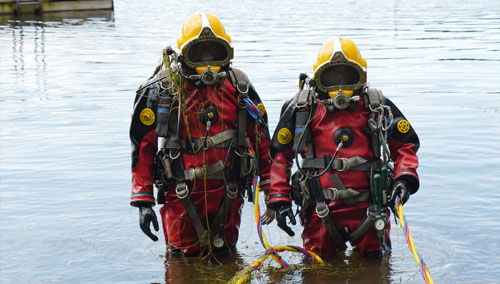A deep dive into the BC RCMP Underwater Recovery Unit
B.C., Underwater Recovery Services
2023-10-20 13:20 PDT
File # A deep dive into the BC RCMP Underwater Recovery Unit
A group of friends were hiking along a trail high above Shannon Falls Provincial Park when one got too close to the swift water and was dragged down by the powerful current. Two others tried to help but they, too, got swept over the falls, tumbling down the mountain into the turbulent waters and dropping into a rocky pool 30 metres below.
Multiple RCMP specialized units and emergency crews rushed to the scene. The search and rescue operation stretched over two days and, eventually, it became a recovery mission.
The Aerial Extraction Team (part of the Lower Mainland’s Integrated Emergency Response Team) used a rope access system to lower us down into the pool where these people were located,
says RCMP Sergeant Steve Pebernat of the Underwater Recovery Team. Then Air Services used a longline to extract the bodies from the pool and off the side of the mountain. In all, we had over 100 officers and first responders with incredible skills working in extremely difficult terrain.
Heavy water flow made it a challenge for the crews involved in the efforts as Shannon Falls runs through a number of pool systems.
It was tragic,
says Pebernat. Three young people lost their lives. It was one of the most complex calls that we’ve done for us to recover them.
The Underwater Recovery Team (URT) is a unique unit of expert divers who train in specialized police diving techniques which are much different than recreational diving.

We want everyone coming to the team to be a police officer first,
says Pebernat. We want them to develop their skills as an investigator as well as a recreational diver. We train them to be a police officer underwater.
In 2005, the RCMP opened the National Underwater Recovery Training Centre (NURTC) in Nanaimo, Canada’s only dive training centre dedicated to preparing police officers as underwater recovery and forensic specialists.
The five-week induction course is intensive. It ensures the divers are competent in all aspects of specialized scuba techniques, including basic evidence recovery operations and swift water rescue operations. Divers must attend annual training and recertification.
Admittedly, underwater recovery is not for everyone. They often dive in dark, murky water with zero visibility. They search by feel. Divers are feeling for a body – victims of accidents or crimes – who are lost in lakes, rivers or the ocean.
We’re recovering bodies,
acknowledges Pebernat. The only comfort we have is that we are helping to bring closure to the families.
Fifty per cent of the dive calls the team receives are for body recovery and 50 per cent are for recovery of evidence. When people commit crimes, they tend to throw items in the water and URT recovers the evidence. They have dived for the retrieval of bullets, cellphones, weapons, vehicles, boats, even planes, often using a metal detection device. They have been successful in recovering key evidence to further an investigation.
URT divers are police officers first and every piece of evidence must be carefully examined, photographed, surveyed and preserved in accordance with our judicial processes.
During a search, often the community shows up to support the team and the family of the victim,
says Pebernat. It’s tremendous to see that community connection and to be part of it. You know, even though it’s a tragedy, it's great to see such humanity come out to support the police in all our actions to recover the victim. To me, it’s very rewarding to have that recognition from the community in such a tragic time.
Pebernat has been a police officer for 30 years; 26 of those have been with the dive team. When I started my career, my field trainer stressed the importance of doing something different other than your Monday to Friday job with the RCMP,
says Pebernat. Given that I had been a recreational diver since 1993, I joined the dive team.
The divers are part-time which is over and above their regular policing duties. As divers are needed throughout the province, even if they are transferred to a different city, they can still be part of the dive team.
The team can be called out to as many as 90 dives a year. The dives can be as short as three hours to as long as a week. They will try to get divers from the closest geographical area to muster a team. The team consists of three to five divers, depending on the call. URT currently has 24 divers in the Province. They once had 34 divers which spread the work more evenly across the teams.

A call-out can happen any time of day or night, and when it does, members from across the province—sometimes from across the country—respond. This is not a nine-to-five job and each operation is as unique as the last.
In addition to diving operations, many members are trained and equipped to operate a variety of side scan sonar and Remotely Operated Vehicle (ROV) technology, further expanding the unit’s operational capabilities.
URT has embraced the latest diving sciences, subsequently earning a reputation as one of the most competent and qualified police dive units in North America. Not only have they brought closure to many families, they have been instrumental in providing a forensic service for many serious criminal investigations.
In waters that exceed a diver’s capability, they will use an underwater ROV equipped with GPS, sonar, high-definition a video camera and special lighting. Technology and equipment are used for diver’s safety. They will put the equipment in places where they can’t go or where it is dangerous for divers to do the initial exploration.
To see what is under the water before diving, the team drops a sonar which sends sound waves to detect objects underwater. The sonar is mounted on a tripod tethered to the police vessel and is lowered to the bottom of the water. The sonar head spins, sending out a sonar beam and those images are seen by the crew above. The team can see beneath the sea by exploring the targeted section of water where they have calculated that they will find the person or evidence before they dive; a much safer prospect.
However, not all surfaces of the bottom of a lake are smooth, particularly if it is a man-made lake that tends to have black holes or craters, making it difficult to operate the sonar.
Harrison Lagoon is an artificial body of water, divided from Harrison Lake by a fabricated sand bar. A man fell swimming and floated out further than was expected.
There was zero visibility,
says Sergeant Dennis Webber, Coordinator of the URT. We’re wearing heavy scuba gear in shallow, very warm water, and we can’t hydrate.
We did a sonar search, but there were black holes at the bottom of this man-made lake,
says Webber. There were big potholes – depressions at the bottom – that made it near impossible to balance the tripod and get an accurate reading.
After four days, they changed their approach to the search.
We changed from the typical pendulum search where you arch from a central point, move up a few meters, and arch again,
says Webber, who has been on the dive team since 2007. Instead, we swam out to the furthest extent of the hardline cable connected to our vessel, and conducted a grid search from there. It was difficult. But we didn’t quit. We found the swimmer.
The divers wear rubberized dry suits to protect them against contaminants It’s completely sealed at the wrists and from the head down. The compressed air tanks are steel so they are heavier than sports divers use. They wear a full-face AGA mask with a microphone and earpiece that allows them to talk to one another as well as the safety diver on the vessel. All told, the suit and gear weighs 100 pounds.

With that much gear, it can be difficult to access and exit a site. Particularly, when they are diving into dangerous waters. One summer, a woman drove her vehicle off a cliff and crashed into a deep lake.
The truck went off the highway, down a massive embankment, down a cliff, and landed nose down in 140-feet of steep water, 20-30 feet from shore,
says Webber, an RCMP officer for 22 years. You have to use all of your skills to recover someone in that depth. But we recovered her body.
When we go to calls, we always work in partnership,
says Pebernat. Very rarely is it just us onsite. We assist the detachment in its investigation. For us to haul that truck out of the water, a lot of divers had to get down to the site, rig the vehicle, and attach it to a cable that was connected to a crane on a barge.
Despite the volatile nature of the underwater environment and the complexity of the equipment, the divers love what they do.
It’s a really great team to work with,
says Webber. We’re so cohesive. Great camaraderie. We don’t wear our rank, so whoever is the supervisor that day – it could be a fairly junior constable – but that constable is wearing the vest today.
My mentor, Staff Sergeant Doug Gambicourt (Ret.), who was URT Coordinator for 13 years, set the tone for the team
, says Webber. That’s why it is so cohesive. It’s the only place I found in the RCMP where there is this high level of Esprit de Corps. They know what they do matters.
It’s not a glamourous job,
says Webber. It can be miserable. But we’re invested. We want to bring the person back home to their loved ones. We never get tired of it.
BC RCMP Communications Services
778-290-2929
Follow Us:
- Date modified: